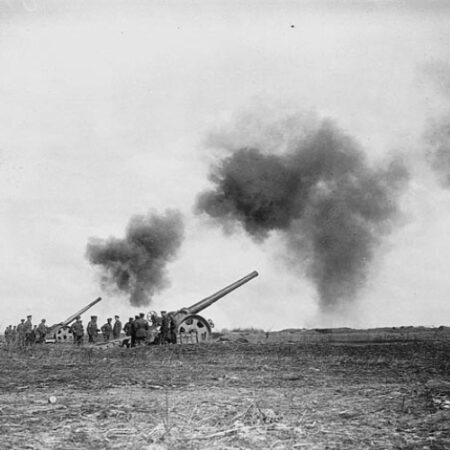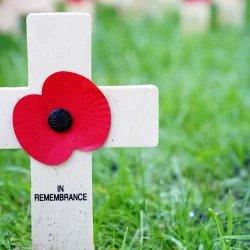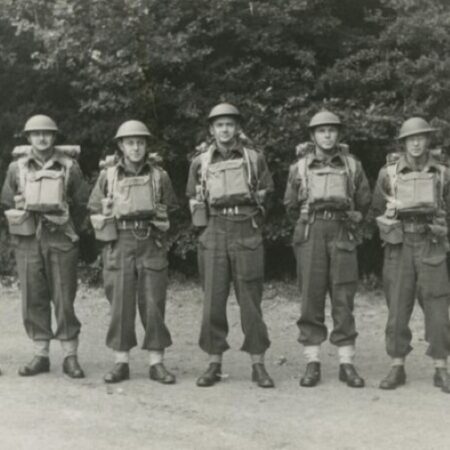Harry H. Dinning, originally from the Township of Ireland in Quebec, enlisted in the army in 1916 before tragically disappearing during the Battle of Ancre Heights. A memorable figure in Maple Grove, Harry H. Dinning’s story is a testament to the military participation of English-speaking communities in the Chaudière-Appalaches region during the Great War.
Harry H. Dinning was a soldier from the then existing town of Maple Grove in the county municipality of Irelande Township, Quebec. Today, his sacrifice is commemorated at the Holy Trinity heritage site in Irelande Township. Let’s explore the story of this young man so that his legacy reaches beyond the doors of the church that cradled him in his youth.
The Dinning Family’s Origins
In the 19th century, the Dinning family settled in Irelande Township, a regional county municipality in the Chaudière-Appalaches region of Quebec. The first clue to their settlement here is in the town’s roads, as one of the route leading to Maple Grove is named after the family. Like the Dinnings, many others who settled in Irelande Township in the 19th century were Anglophone, and they hailed from Ireland, Scotland and England.
While this demography showed promise for the future of hundreds of Anglophone families, the trend started to change drastically in 1870, when more and more Francophones took over the land in this area bordering the seigneuries. The French Catholic push into the region led to a gradual but steady exodus of young Anglophones to other parts of Canada or the United States.
Like many young people at the time, Harry Humphrey Dinning, who was born in Maple Grove, went out to Western Canada and settled in Calgary. The story of this soldier of Irish descent who went missing in October 1916 at the Battle of The Ancre Heights is part of not only Canadian military heritage but also the legacy of the Anglophone community that originally settled in Irelande Township, which is what makes Dinning’s story so unique.
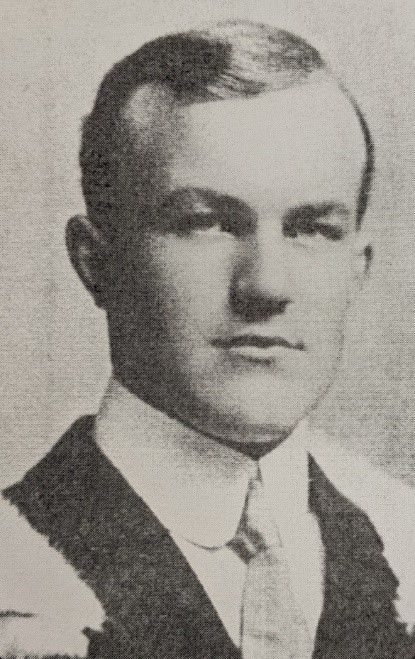
Overseas Deployment

Harry H. Dinning was born in Maple Grove on February 3, 1890. He enlisted in Calgary, and number of errors are found on his recruitment certificate. First, the young man’s name was given as “Leonard Henry.” It is unclear why the Leonard was added. The administrator may have simply reused an old enlistment document and crossed out the first name listed on it. However, his father’s name (William Dinning), his birthplace, and his date of disappearance indeed proves that this soldier named Henry was in fact Harry H. Dinning.
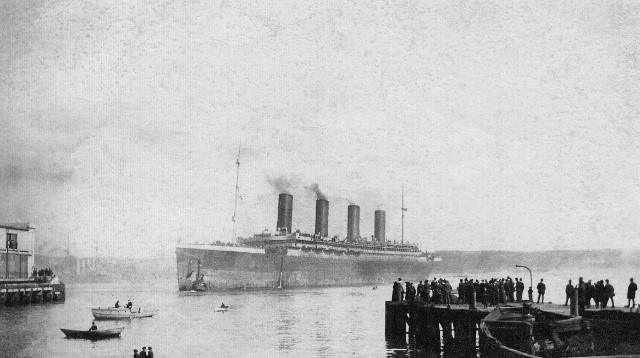
After living in Western Canada for some time, the 26-year-old joined the army of his own accord on April 18, 1916, a few months after Robert Borden’s government announced that it was sending 500,000 more soldiers to Europe. Dinning also enlisted during a year marked by a significant increase in Canadian deaths in the war. On June 28, the young volunteer boarded the RMS Olympic bound for Liverpool, England. A week later, on July 5, Dinning set foot on English soil for the first and last time. Reassigned to Princess Patricia’s Canadian Light Infantry (PPCLI), he was deployed to France and joined his unit on August 28. Like many of his fellow enlistees, Harry did not undergo full military training before being deployed. The high casualty rate from the conflict’s stalemate impacted the extent of the recruits’ military training. The only time available to the troops to become familiar with their environment, unit members, and equipment was between their arrival to the theatre of operations and their deployment to the front lines.
Arriving at the Front
On September 18, 1916, the three battalions and its reserve of PPCLI were detached to the front lines. Part of the 7th Canadian Infantry Brigade and considered the army’s shock troops, the PPCLI were only deployed for major operations. This was how Dinning found himself on the front lines of a burgeoning large-scale offensive. The PPCLI troops had the heavy task of laying the course for the tough battle ahead.
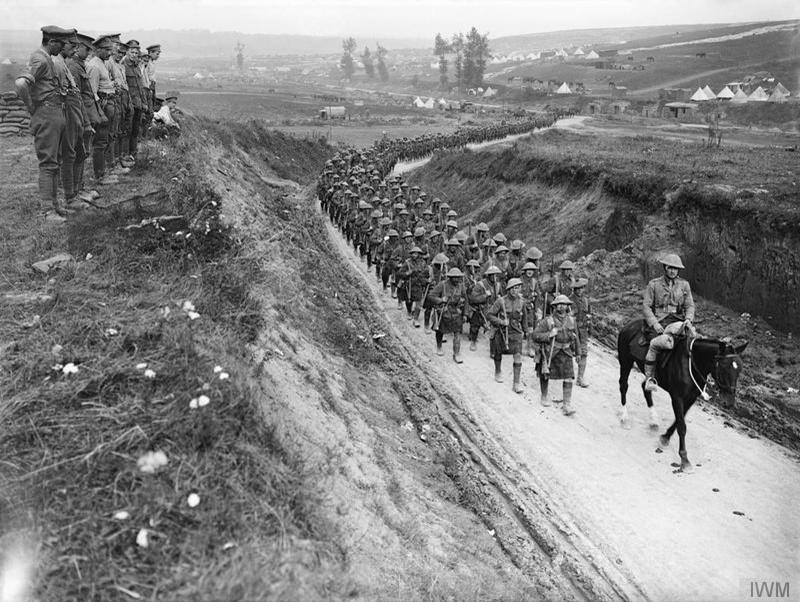
The Battle of Ancre Heights was part of the offensive of the Battle of the Somme and took place on October 1 at 3:15 p.m. The goal was to take the Regina Trench in order to break through the German lines set up a few hundred metres from the village of Courcelette. However, the operations between October 1 and 7 were fraught with failures and high casualties. Heavy rain and the effectiveness of the German artillery halted the advance of the Canadian, French and British troops.
A new offensive was launched at 4:50 a.m. on the cold and rainy morning of October 8 that involved 1,100 Canadian soldiers, including the PCCLI reserve to which Dinning was presumably assigned. This operation by the 7th Canadian Infantry Brigade and PCCLI was a disaster. The Canadian bombardments completely missed their targets, and the German lines remained intact. Only the 3rd and 4th brigades broke through the German lines to the east before being quickly driven back. That same day, wounded in action was recorded in Harry H. Dinning’s file, which was later replaced with wounded and missing. In August 1917, William Henry Dinning, Harry’s father, received $94.26 (about $1,800 in today’s dollars) to compensate for the loss of his son, who was officially recognized as dead by the Canadian Army.
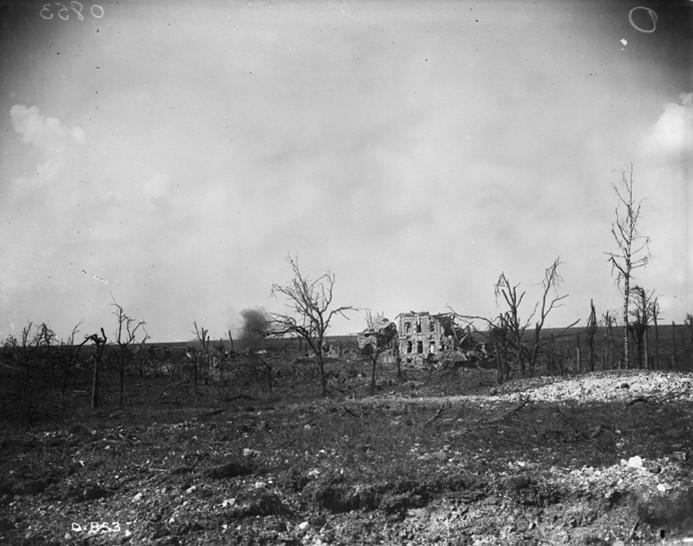
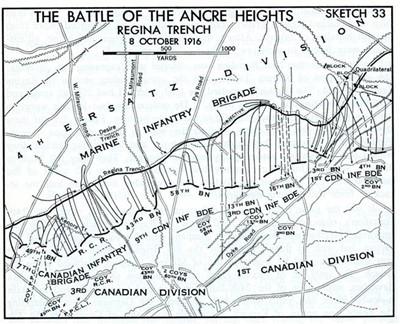
Commemoration and Mourning in Maple Grove
Messages of sympathy for the Dinning family appeared in the Thetford Mines newspaper Le Canadien dated November 9, 1916. Difficult combat conditions, so many missing soldiers, and a considerable increase in deaths contributed to the drop in enlistments in 1916.
These brave soldiers must be commemorated. As for Harry H. Dinning, the evidence of his sacrifice can still be seen in the Anglican Church of Maple Grove. Located on the Holy Trinity heritage site founded by Anglo-Protestant pioneers in the early 19th century, the Anglican church has a pulpit and stained-glass window honouring the young soldier. To understand why these memorials were put up, let’s look at why this family was so important in the Irelande Township municipality.


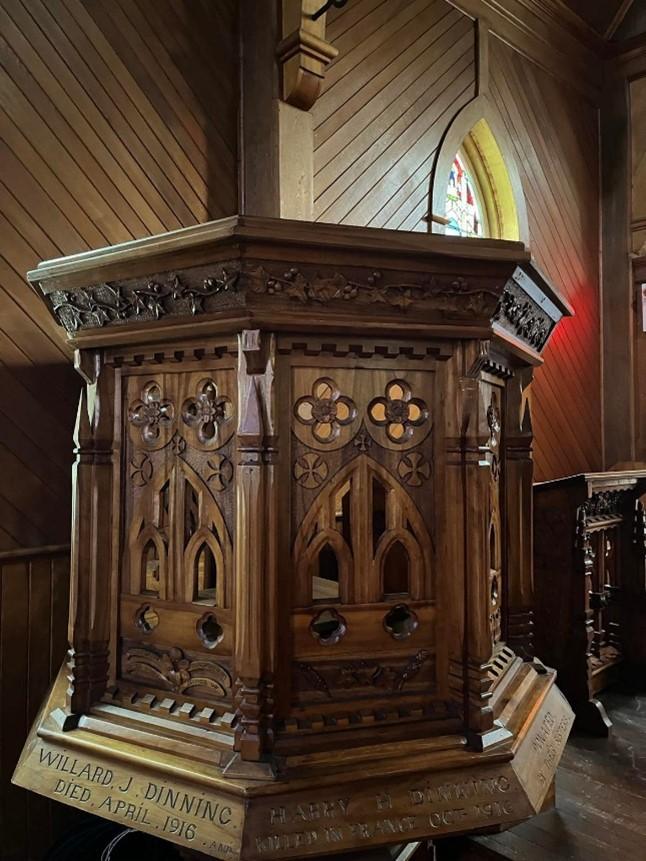
Below, left & center: This window, like the pulpit, was donated by the Dinning family. In honor of their nephew, Harry H. Dinning’s aunts inscribed the following at the bottom of the window: “To the glory of God and in the memory of Harry H. Dinning, who was serving with the C.E.F in France and reported missing on October 8, 1916. In the light, we shall see the light. This stained glass window was erected by his aunts”.
Below, right: The pulpit was donated by the sisters of the Dinning family to commemorate the death of two of their brothers. It reads: “In memory of Williard J. Dinning. Died, April 1916. and Harry H. Dinning. Killed in France, Oct – 1916”.
The Dinning Family in Irelande Township: Part Fiction, Part Fact
Many memorials attest to the Dinning family’s presence in Irelande Township. In an article published in 2000, amateur historian Rénald Turcotte dated the Dinning family’s arrival to around 1850, when George settled in Maple Grove. This branch of the Dinning family descended from Henry Dinning, a wealthy businessman from Quebec City. This claim, however, is based solely on the fact that a forebear of the Irelande Township Dinnings is named H. Dinning in the Annals of Megantic, a seminal reference of the history of Megantic County, published in 1900. After comparing the dates of birth of George (1827) and Henry (1830) and observing that they both came from Quebec City, Rénald Turcotte raised the possibility that they were brothers. Unfortunately, the archives that could have verified these facts were burned in the fire of the registration office of the main county town of Inverness on December 8, 1889. We do know that George married Margaret Humphrey on April 29, 1850 at the Cathedral of the Holy Trinity in Quebec City. William, Henry Humphrey’s father, was born from this union in 1853.
The legacy of the Dinning family can also be seen in the art and architecture of Maple Grove’s Anglican Church. When the county’s second church was erected in 1900, contractor Thomas R. Porter built the vaulting to resemble a ship’s hold. A number of history buffs link this design to the shipyard owned by Henry Dinning, the alleged brother of George, in the second half of the 19th century.


Plus, many of the stained glass windows in the church were donated by the family, gifts that attested to their notable socio-economic status. The supposition is that George was a major lumber merchant who potentially contributed to his brother Harry’s shipyard in Quebec City. However, all we know for certain is that George Dinning became one of the biggest animal traders in the region and that that he was a land speculator with many land holdings. The specific links between these merchant families from Quebec City and Irelande Township are unclear but plausible considering George’s position of stature when he arrived to Maple Grove around 1850.
We also know that Harry H. Dinning, son of William and Florence Nightingale Ward, was baptized on April 4, 1890 at the first Church of England in Irelande Township. He attended elementary school in Maple Grove before attending Bishop’s College in Lennoxville. He continued his law studies at McGill University and became a lawyer before moving to live with his aunt Elizabeth Dinning Nobel in Calgary, where, in 1916, he joined the Canadian Expeditionary Force for the final journey of his life. Harry H. Dinning is one of four soldiers whose military service during the First World War is commemorated in the book of the municipality’s history that was published in 2006. This work also includes the names of George Russell (home boy) (killed in action), Archibald Merril Simons (survivor), and Quincy Henry Cross (wounded in action).
Article written by Pierre-Gabriel Gosselin, Master’s candidate in history at Sherbrooke University, for Je Me Souviens. Translated by Amy Butcher (traductionsamyb.ca).
Sources:
- “Ancre, 1916“, Gouvernement du Canada/Government of Canada.
- “Battle of Courcelette“, Encyclopédie Canadienne/The Canadian Encyclopedia.
- “Courcelete” in Canada and the First World War, Musée Canadien de la guerre/Candian War Museum.
- “First World War (WWI)“, Encyclopédie Canadienne/The Canadian Encyclopedia.
- “Henry Dinning“, Dictionnaire biographique du Canada/Dictionary of Canadian Biography.
- “Maple Grove“, Le Bercail, vol 9, n°1, 2000, 35 p. (in french).
- “Princess Patricia’s Canadian Light Infantry (PPCLI)“, Encyclopédie Canadienne/The Canadian Encyclopedia.
- “Private Henry Humphries Dinning“, Gouvernement du Canada/Government of Canada.
- “Voluntary Recruitment” in Canada and the First World War, Musée Canadien de la guerre/Candian War Museum.
To consult archival documents of Harry H. Dinning, you can visit the Library and Archives Canada website:
- “Henry Humphreys Dinning (228220)” (# d’item 355578), Record Group: Canadian Expeditionary Force (CEF), List: RG 150.
For a more academic approach:
- Wilfrid Grimar, Municipalité d’Irlande : 200 ans d’histoire – Municipality of Ireland : 200 years of history, Irlande, Municipalité d’Irlande, 2006, 264 p.
- Jean-Pierre Kesteman, Diane Saint-Pierre and Peter Southam, Histoire des Cantons de l’Est, Québec, Institut québécois de recherche sur la culture, 1998, 829 p. (in french).



